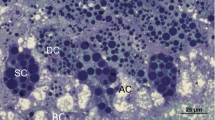Summary
Carausius morosus starved and deprived of water lose about 30% of their body weight in 4 days, mainly due to water loss. Isolated inferior tubules from starved dehydrated insects secrete urine at 0.041 nl·mm−1·min−1 compared with 0.118 nl·mm−1·min−1 in those from fed hydrated insects. This difference is due partly to the level of a diuretic (and perhaps also an antidiuretic) hormone in the haemolymph acting directly on the urine-secreting mechanism and partly to changes in the intrinsic capacity of the tubule cells for urine secretion. This latter change is accompanied by structural changes in the tubules. During starvation and dehydration the lumen becomes packed with white granules, the height of the type 1 cells is reduced, their basal infoldings and brush border become shorter and their mitochondrial volume is reduced.
Similar content being viewed by others
References
Beerman, W., Clever, U.: Chromosome puffs. Sci. Amer. 210, 50–58 (1964).
Berendes, H. D.: Gene activities in Malpighian tubules of Drosophila hydei at different developmental stages. J. exp. Zool. 162, 209–218 (1966).
Berendes, H. D.: The hormone ecdysone as effector of specific changes in the pattern of gene activities of Drosophila hydei. Chromosoma (Berl.) 22, 274–293 (1967).
Berendes, H. D., Willart, E.: Ecdysone-related changes at the nuclear and cytoplasmic level of Malpighian tubule cells in Drosophila. J. Insect Physiol. 17, 2337–2350 (1971).
Berridge, M. J.: The physiology of excretion in the cotton stained, Dysdercus fasciatus, Signoret. IV. Hormonal control of excretion. J. exp. Biol. 44, 553–566 (1966a).
Berridge, M. J.: Metabolic pathways of isolated Malpighian tubules of the blowfly functioning in an artificial medium. J. Insect Physiol. 12, 1523–1538 (1966b).
Berridge, M. J.: Urine formation by the Malpighian tubules of Calliphora. I. Cations. J. exp. Biol. 48, 159–174 (1968).
Cazal, M., Girardie, A.: Contrôle humoral de l'équilibre hydrique chez Locusta migratoria. J. Insect. Physiol. 14, 655–668 (1968).
De Besse, B., Cazal, M.: Action des extraits d'organes périsympathiques et de corpora cardiaca sur la diurèse de quleques insectes. C. R. Acad. Sci. (Paris) 266, 615–618 (1968).
Ganote, C. E., Grantham, J. J., Moses, H. L., Burg, M. B., Orloff, J.: Ultrastructural studies of vasopressin effect on isolated perfused renal collecting tubules of the rabbit. J. Cell Biol. 36, 355–367 (1968).
Irvine, H. B.: Sodium and potassium secretion by isolated insect Malphigian tubules. Amer. J. Physiol. 217, 1520–1527 (1969).
Maddrell, S.H.P.: Excretion in the blood sucking bug, Rhodnius prolixus Stål. 1 The control of diuresis. J. exp. Biol. 40, 247–256 (1953).
Mordue, W.: Hormonal control of Malpighian tubule and rectal function in the desert locust, Schistocerca gregaria. J. Insect Physiol. 15, 273–285 (1969).
Pilcher, D.E.M.: Hormonal control of the Malpighian tubules of the stick insect, Carausius morosus. J. exp. Biol. 52, 653–655 (1970a).
Pilcher, D.E.M.: The influence of the diuretic hormone on the process of urine secretion by the Malpighian tubules of Carausius morosus. J. exp. Biol. 53, 465–484 (1970b).
Ramsay, J. A.: Active transport of water by the Malpighian tubules of the stick insect, Dixippus morosus (Orthoptera, Phasmidae). J. exp. Biol. 31, 104–113 (1914).
Ramsay, J. A.: The excretory system of the stick insect, Dixippus morosus (Orthoptera, Phasmidae). J. exp. Biol. 32, 183–199 (1955a).
Ramsay, J. A.: The excretion of sodium, potassium and water by the Malpighian tubules of the stick insect, Dixippus morosus (Orthoptera, Phasmidae). J. exp. Biol. 32, 200–216 (1955b).
Taylor, H. H.: Ultrastructural studies on the Malpighian tubules of the stick insect. Ph. D. Thesis, University of Newcastle upon Tyne (1970).
Taylor, H. H.: Water and solute transport by the Malpighian tubules of the stick insect, Carausius morosus. The normal ultrastructure of the type 1 cells. Z. Zellforsch. 118, 333–368 (1971a).
Taylor, H. H.: The fine structure of the type 2 cells in the Malpighian tubules of the stick insect, Carausius morosus. Z. Zellforsch. 122, 411–424 (1971b).
Unger, H.: Der Einfluß der Neurohormone C und D auf die Farbstoffabsorptionsfähigkeit der Malpighischen Gefäße (und des Darmes) der Stabheuschrecke Carausius morosus (Br). in vitro. Zool. Jb. Physiol. 71, 710–717 (1965).
Wall, B. J.: Regulation of water metabolism by Malpighian tubules and rectum in Periplaneta americana L. Zool. Jb. Physiol. 71, 710–709 (1965).
Wigglesworth, V. B., Salpeter, M. M.: Histology of the Malpighian tubules in Rhodnius prolixus Stål (Hemiptera). J. Insect Physiol. 8, 299–307 (1962).
Author information
Authors and Affiliations
Rights and permissions
About this article
Cite this article
Taylor, H.H. Structural and functional changes in the malpighian tubules of Carausius morosus during dehydration and starvation. Z.Zellforsch 141, 479–492 (1973). https://doi.org/10.1007/BF00307119
Received:
Issue Date:
DOI: https://doi.org/10.1007/BF00307119




